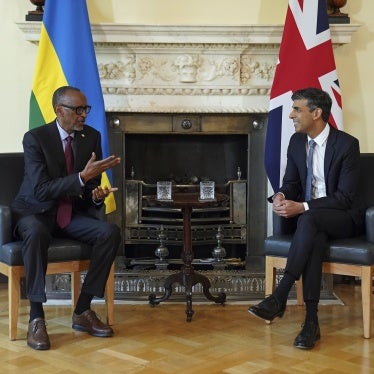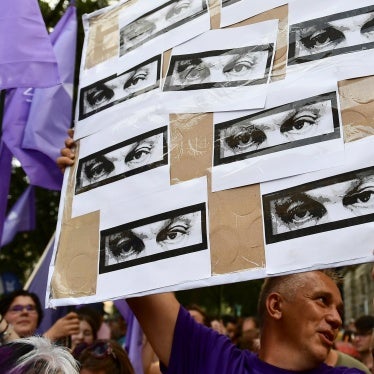Oleksandr Turchynov
Acting President of Ukraine
Petro Poroshenko
President-Elect of Ukraine
Dear Sirs,
I am writing to raise issues relating to the conduct of military operations in southeastern Ukraine in light of the growing number of credible reports regarding Ukrainian forces’ use of mortars and other weapons in and around populated areas, and the recent intensifying of hostilities between Ukrainian forces and armed insurgent groups. While we have not been in a position to investigate the most recent hostilities or many of the incidents reported in the press in the past week, our researchers did investigate two apparent mortar attacks in residential areas while on a field mission in Donetsk region between May 19 and May 26.
Human Rights Watch researchers traveled to residential areas in and around Sloviansk, where they documented significant damage to several residences and one case of damage to a hospital as a result of alleged shelling by Ukrainian forces.
On May 23, Human Rights Watch researchers visited the village of Semyonovka, on the outskirts of Sloviansk, and interviewed three local residents whose houses suffered various degrees of damage from shelling by mortars in the previous days.
“Andrey” and “Evgeniya” (not their real names) of Semyonovka told Human Rights Watch that the shelling lasted three nights and had become more frequent and longer in duration each night. They described the whooshing sound of something ripping through the air immediately prior to the detonations and said they had hid in the basement every night out of fear that their homes would be hit. They said that at least nine houses in the village suffered serious damage, five of them during the night of May 22-23.
One of the homes that suffered significant damage was that of 80-year-old Zinaida Paskan, who lives on Vesennaya Street in a one-floor house consisting of three rooms and a kitchen. Paskan told Human Rights Watch that much of her house was destroyed in a strike on the evening of May 21.
She told Human Rights Watch,
I was sitting on the sofa reading the Bible and suddenly there is this terrible noise and the wall just collapses, and everything [the debris] is flying around.… I just ran and hid under the table.... For the past two nights, I’ve been hiding in my neighbor’s basement.
Human Rights Watch researchers examined Paskan’s house, which was largely destroyed. They saw a large hole in the ground about one meter from the house, created where the shell hit, with shell fragments, which according to experts’ assessment and photographs of the fragments were from a 120-milimiter mortar, distributed around the hole.
Human Rights Watch saw that Paskan’s living room was fully destroyed, as was part of the bedroom, which was also full of debris. The kitchen, located in the back of the house, was damaged by debris but was still intact. The house was left uninhabitable by the damage.
The location and shape of the crater that was created by the shell directly in front of the house suggest a trajectory of the shell consistent with being fired from Karachun hill, the site of the Ukrainian military base across from Sloviansk. The statements taken from Paskan and other village residents support such a conclusion.
Human Rights Watch examined another house on the same street, which was half destroyed by a shell the night before. Human Rights Watch also saw three other severely damaged houses nearby. Two of them still had smoldering roofs, as they had apparently caught fire from the shelling of the previous night. All the damaged houses appeared to be in one, lower, section of the village. The residents told Human Rights Watch that the entire lower part of the village lost electricity two days previously, apparently as a result of the shelling. The residents also said that a female resident of Semyonovka was hit by a shell fragment two days earlier and was hospitalized with a head wound. A medical worker from Sloviansk later confirmed this information to Human Rights Watch and said that the woman had received treatment at the local hospital and left the area with her family.
On May 25, Human Rights Watch researchers visited the site of a psychiatric hospital in the town of Sloviansk that had been hit with a mortar shell early that morning but which had not exploded.
The researchers examined the damage caused by the dud to the wall of one of the hospital buildings – a large hole in the wall between the second and third floors. The mortar dud also partly destroyed windows in that segment of the wall. There were fragments of shattered glass on the ground in front of the building.
Human Rights Watch researchers interviewed two nurses who work at the hospital. The nurses told Human Rights Watch that the damaged building was the in-patient wing which accommodated 28 elderly (between ages 70 and 80) and immobile patients. The nurses said that a group of insurgents had come to their hospital wing at around 5.30 p.m. the night before the attack as the staff was bringing dinner to patients. The insurgents warned the hospital staff that there would be shelling during the night and offered help with evacuating patients. It is not known to Human Rights Watch why or how the insurgents knew there was going to be shelling. The hospital staff, with the help from the insurgents, led (and carried on stretchers) the patients to the basement of a neighboring hospital building at around 7 p.m. The patients spent the night in the basement, together with some of the nursing staff.
The two nurses Human Rights Watch interviewed said they went home after taking the patients to the basement, but that patients and hospital staff who were in the basement all night later told them they heard explosions several times during the night. A particularly loud explosion came at around 5:30 a.m.
Judging from interviews with people at the scene, it seems that there was both incoming and outgoing fire, although Human Rights Watch could not establish the location of the outgoing fire.
When the hospital staff and the patients finally left the basement at around 8 a.m., they saw that their building was hit. The two nurses Human Rights Watch interviewed said that they got to work at around 8 a.m. on May 25 and saw the damage.
Human Rights Watch researchers saw numerous armed insurgents both on May 23 in Semyonovka and on May 25 on the ground of the psychiatric hospital. The insurgents had set up numerous checkpoints in the area. In Semyonovka, for example, there was a checkpoint several hundred meters from Paskan’s home. Other villagers told Human Rights Watch that the insurgents “are there to protect us, and so they shoot at the military [Ukrainian servicemen] on that [Karachun] hill to prevent them from attacking us.” At the time of Human Rights Watch’s visit to Sloviansk, there was an insurgent checkpoint immediately next to the psychiatric hospital. When asked by Human Rights Watch if the insurgency had set up positions in the hospital, a nurse said, “I’m not at liberty to say” just as several armed men in camouflage were crossing the courtyard to join a larger group standing in the other part of the courtyard.
As noted above, the nurses also said that in recent days there had been a regular exchange of fire between the insurgents and the Ukrainian servicemen. Witnesses also confirmed to Human Rights Watch that the insurgents possess and use mortars when they engage Ukrainian forces.
Human Rights Watch recognizes that the actions of the insurgents violate Ukrainian law and that the Ukrainian government is entitled to carry out law enforcement and military operations to counter the armed insurrection. We also recognize that the actions of the insurgents, operating in a populated residential area, setting up road blocks in residential areas, and moving in, around, or near to hospital grounds may endanger residents, patients, and healthcare workers at such facilities.
Nevertheless, criminal conduct by the insurgents does not relieve the Ukrainian forces of their obligations to act in accordance with international law in the conduct of their law enforcement and military operations. This is particularly the case with respect to use of lethal force. In Ukraine the obligations under the European Convention on Human Rights (ECHR), such as those which protect the right to life (article 2), bodily integrity (article 3), and liberty and security (article 5), as well as the inviolability of the home (article 8), remain in force during all law enforcement and military operations. (See for example the cases of Ergi v. Turkey, judgment of 28 July 1998, Reports 1998-IV and Isayeva v. Russia (2005), in which the European Court of Human Rights articulated the scope of the state’s obligations in the conduct of counter-insurgency operations.)
Article 2 of the ECHR provides that deprivation of life is not a violation of the right to life “when it results from use of force which is no more than absolutely necessary” in among other things, “action lawfully taken for the purpose of quelling a riot or insurrection.” Requiring that use of force be no more than “absolutely necessary” means the force used must be strictly proportionate to the achievement of the permitted aims. It also requires an examination of whether the operation was planned and controlled by the authorities so as to minimize, to the greatest extent possible, risk to life. The government’s responsibility will be engaged where they fail to take all feasible precautions in the choice of means and methods of a security operation mounted against an opposing group with a view to avoiding and, in any event, minimizing, incidental loss of civilian life (see Ergi para 79).
In so far as the ongoing hostilities are governed by international humanitarian law, the government also has obligations never to direct attacks at civilians or civilian objects or to engage in indiscriminate attacks, to distinguish at all times between civilian objects and military objectives, and to adhere strictly to the principle of proportionality insofar as attacks that may cause incidental loss of civilian life, injury to civilians, or damage to civilian objects, in excess of the concrete and direct military advantage anticipated, are prohibited. Under international humanitarian law the insurgents are bound by the same obligations, and under human rights standards, all parties must take all feasible measures to avoid, and in any event to minimize, incidental loss of civilian life, injury to civilians, and damage to civilian objects.
As noted above, Human Rights Watch is aware of physical harm to only one individual among Semyonovka residents and none among the hospital staff and patients. This does not diminish our concern that that the use of unobserved indirect fire, like shelling by mortars, in these two operations against insurgents may not have been a proportionate response to the threat of the insurgents and may not comply with Ukraine’s obligations to protect the right to life and to respect the home and property of its population.
We urge you to review all ongoing operations in Semyonovka, Sloviansk, and elsewhere to ensure that in carrying out counter-insurgency operations, Ukrainian forces are fully aware of all their obligations under international law and that the use of lethal force that may result in the death or injury of civilians or may cause unjustified harm to civilian property and infrastructure is strictly justified under international law.
Sincerely,
Hugh Williamson
Director
Europe and Central Asia Division
Human Rights Watch








